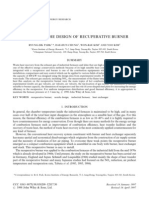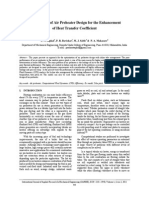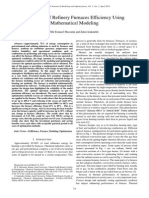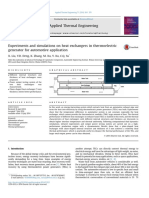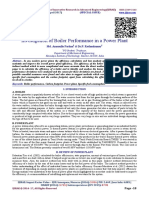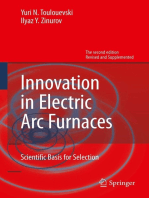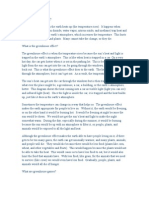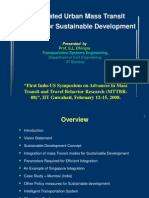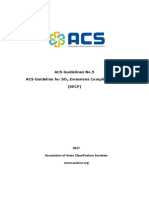Investigation of Turbulators For Fire Tube Boilers Using Exergy Analysis
Investigation of Turbulators For Fire Tube Boilers Using Exergy Analysis
Uploaded by
Mustafa HejairCopyright:
Available Formats
Investigation of Turbulators For Fire Tube Boilers Using Exergy Analysis
Investigation of Turbulators For Fire Tube Boilers Using Exergy Analysis
Uploaded by
Mustafa HejairOriginal Title
Copyright
Available Formats
Share this document
Did you find this document useful?
Is this content inappropriate?
Copyright:
Available Formats
Investigation of Turbulators For Fire Tube Boilers Using Exergy Analysis
Investigation of Turbulators For Fire Tube Boilers Using Exergy Analysis
Uploaded by
Mustafa HejairCopyright:
Available Formats
Turk J Engin Environ Sci 25 (2001) , 249 258.
c TUBITAK
Investigation of Turbulators for Fire Tube Boilers Using Exergy Analysis
Bet l AYHAN u Karadeniz Technical University, Ordu Training Center, Ordu-TURKEY Cevdet DEMIRTAS Karadeniz Technical University, Mechanical Engineering Department Trabzon-TURKEY
Received 28.08.1997
Abstract In this paper, an experimental study of ve dierent types of turbulator inserts for re tube boilers is presented. The experimental setup was constructed in the Department of Mechanical Engineering Laboratory of Karadeniz Technical University. It was tested to evaluate the boiler eciency according to TS 4040 standard, and to evaluate the second law eciency of thermodynamics for the cases with and without inserts under the same operating conditions. Four new types of turbulator consisted of truncated hollow cones. They were placed in tandem parallel to the gas ow direction to allow no contact with the re tube wall. The half-apex angles of the conical turbulators used in the experiments were 14 and 20 . The number of the turbulators inserted in the of the boiler was 200, their installation arrangements in the re tubes were periodic, and their enlarging positions were in accordance with the gas ow direction. It was found that turbulators increased the boiler eciency from 8% to 12% and the second law eciency of the boiler from 24% to 27%. It is also shown that the one with the half-apex angle of 20 gives better results, about 4% enhancement compared with the other ones. A fth new turbulator, consisting of a truncated half-cylindrical surface and placed in tandem with ow direction, also periodically interrupted and transposed in the re tube boilers, provided a 4% increase in the boiler eciency. The second law eciency of the boiler was improved from 24% to 25.2%. It was also shown that there was no need to use an excess fan for the ue gas in the chimney because of the very low pressure drops in the new types of turbulator. Key Words: Boiler, Turbulator, Fire Tube, Eciency, Exergy
Ekserji Analizi Kullanlarak Duman Borulu Kazanlarda Trblatrlerin u u o Incelenmesi
Ozet Bu yaynda, duman borulu kazanlar iin be yeni tip trblatrlerin deneysel calmas ele alnmtr. c s u u o s s Kazan deney dzenei, Karadeniz Teknik Universitesi Makina Mhendislii Blm Laboratuvarnda kuu g u g ou u rulmutur. Kazan, ayn iletme artlarnda trblatrl ve trblatrsz durumlar iin TS 4040 standarts s s u u o u u u o u c larna gre tanmlanan kazan verimi ve Termodinamiin ikinci kanununa dayal verimi belirlemek uzere o g kazan test edilmitir. Drt yeni trblatr, kesik halka koniden meydana gelmekte ve bunlar ak ynnde s o u u o s o u paralel ve boru cidarna demeyecek ekilde yerletirilmilerdir. Kesik halka konilerin yarm tepe alar g s s s c 14 ve 20 seilmitir. Kazan ierisine yerletirilen 200 adet trblatrler duman borular ierisine ak c s c s u u o c s
249
AYHAN, DEMIRTAS
ynnde genileyecek ekilde yerletirilmi olup, birinci kanun verimini trblatrsz duruma gre % 8 ila % o u s s s s u u o u o 12 artrd ve ikinci kanuna dayal kazan verimini de % 24 den % 27 ye ykseltii bulunmutur. Yarm tepe g u g s as 20 olan kesik halka konili trblatrlerin dierlerine gre daha iyi sonu verdii ve dierlerine gre % c u u o g o c g g o 4 etkili olduu gzlenmitir. Beinci yeni tip trblatr, kesik yarm silindirik halka yzeyli ve saptrlm g o s s u u o u s trblatrler, gaz akz ynne paralel yerletirilerek yaplan deneylerde birinci kanuna dayal kazan verimu u o o u s inde % 4 lk bir verim artna neden olmutur. Ikinci kanuna dayal kazan veriminde ise % 24 den % 25.2 u s s ye kadar bir art salamtr. Yeni tip trblatrler basn kayb ok az olduundan, kazan tesisinde baca s g s u u o c c g gazlarn cekmek iin ilave bir fana gereksinim duyulmayaca gsterilmitir. c g o s Anahtar Szc kler: Kazan, Trblatr, Alev borusu, Verim, Ekserji o u u u o
Introduction In recent years, energy saving has been studied extensively, taking into consideration air pollution and shortage of energy sources. Investigations for these purposes show that boiler eciency is an important parameter. Any improvement in the eciency of boilers, where fossil-based fuels are used, causes energy savings and economical energy usages. The majority of Turkeys energy requirements Turkeys are satised by imported energy. Approximately 50 percent Turkeys of total energy will be supplied by foreign countries after 2010. In this situation, the importance of saving energy and reducing fuel consumption is obviously important. The use of availability and irreversibility in an actual problems from a thermodynamics point of view is of growing importance for thermo-economic design. Theoretical and experimental analyses were carried out on a boiler to see what happened to the availability of the air-fuel mixture that entered the furnace and where the irreversibility occurred during the process. In many engineering decisions, other factors, such as the impact on the environment (for example, air pollution) and the impact on society, must be considered when developing the optimum design. In connection with the increased use of availability analysis in recent years, a term called second law eciency has come into more common used. This involves a comparison with the cost, or input, in terms of the thermodynamic availability (Van Wylen and Sonntag, 1985). The thermal eciency of a boiler is calculated indirectly by thermal loss estimation or directly with the rst law of thermodynamics. In reality, the amount of energy is as important as the energy quality and energy usage. Therefore, the second law of thermodynamics is sucient for the optimum design for all processes. In order to increase boiler eciency, combustion eciency is an important parameter. The research on the eects of improved combustion process on 250
boiler eciency shows that the eciency was increased 5% for the complete combustion process in comparison with the incomplete combustion process (T ter, 1974). A lot of research has been done on the u use of dierent kinds of fuels in boilers. Research on boilers capable of using fuel oil and natural gas show that to produce the same amount of outputs under similar operating conditions, 470 kg/h of fuel oil and 370 kg/h of natural gas were consumed. When the ue gas temperature decreases in the chimney, the boiler eciency increases, and also during the process, combustion thermal losses and fuel consumption decrease (Tenir and Kincay, 1992). The eect of turbulators developed in the Mechanical Engineering Department of Karadeniz Technical University on fossil fuelled hot water boilers is investigated in this study. Exergy Balance Exergy concept For a given environment, energy which is convertible into other forms of energy is called Useful Energy or Exergy. Energy which is impossible to convert into other energy forms is called Useless Energy or Anergy (By ktr, 1986). u u u Energy = Exergy + Anergy The determination of the useful part of a given amount of any energy form (just like heat, enthalpy), exergy, is introduced. Therefore, exergy is the maximum possible work for a reversible process from specied initial state to the state of its environment. In accordance with this denition, exergy can be calculated at the given temperature, pressure and composition of the environment and also a reversible process must be considered. For the exergy analysis, a form of reversible process is not needed, like other thermodynamic analysis. Knowing the conditions of
AYHAN, DEMIRTAS
the initial and nal states of the process is enough to calculate the exergy. The exergy balance can be written for the steady-ow process (Arkol, 1985) as follows: Ein Eout + Eloss = 0 (1)
Lost work can be dened as the dierence between maximum work and actual work so Wloss = Wmax. + W = Eloss (2)
not need precombustion was used as fuel in the test. The maximum amount of CO2 in the dry ue gas is 15.4%, the minimum amount of air Lmin = 11.04 m3 /kg, and the amount of dry ue gas Vmin = 11.73 m3 /kg. The mass combustion of motorin consisted of 85% C, 13% H 1.7% O and 0.3% S. The caloric value of motorin was given as 42,636 kJ/kg (Telli, 1989; Ozge, 1989).
At the same time this is equal to exergy loss (Tenir and Kincay, 1992; Arkol, 1985). Experimental Setup Experimental boiler properties The experimental setup was designed and built according to Turkish Standard TS 4041. Its schematic picture is given in Figs. 1 and 2. The low pressure and smoke tube hot water boiler is used in this experimental setup. The outer surface of the boiler is 7.5 m2 , the heating capacity of the boiler is 209,000 kJ/h and its tested pressure is 5.9 bars. Boiler fuel properties Thin combustion oil called motorin, which does
Turbulators The somewhat complex geometries of the truncated conical ring turbulators tested are given in Fig. 3, where the nomenclature used is noted on each gure and a letter is used to identify each insert. Numerical values of the various geometric dimensions are also given in the same gure. The truncated conical ring turbulators were tested by Ayhan et al. (Karabay and Ayhan, 1988; Ayhan and Arc,1985). A 135% to 175% increase in the heat transfer coecient at a Reynolds number of 10,000 was obtained with friction factor increases of nearly 1000%. In a study by Ayhan and Arc (1985), the half apex angles of 14 and 20 were used for truncated conical ring turbulators. They were made of 0.5 mm thick steel plate. Several commercial, arbitrary design, in-
Figure 1. Schematic view of experimental setup
251
AYHAN, DEMIRTAS
3 4
12 8
20
13
18 19 11
16
22
23
15
21
7 24 h
6 h 10 17 1 5 2 14 9
1. Fire door 2. Furnace 3. First smoke-tube 4. Second smoke-tube 5. Boiler shell 6. Blowdown
7. Burner 8. Water outlet pipe 9. Water inlet pipe 10. Inlet safety 11. Outlet safety 12. Junction of measuring instr.
13. Hanger 14. Boiler emplacement 15. Front smoke box 16. Back smoke box 17. Filler and discharge pipe 18. Insulating material
19. Insulating shell 20. Turbulators 21. Orifice 22. Measuring canal of flue gas 23. Fan 24. Butterfly valve
Figure 2. Schematic view of experimental setup.
terrupted and periodically transposed truncated half cylinder surface type turbulators were tested by Ayhan (1996). The fundamental work has been done to establish the heat transfer/ow friction basis for the design of inserts. The geometry and dimensions of the half cylinder surface type turbulator tested are given in Fig. 4, where the nomenclature used is noted on the gure and a letter is used to identify the insert. Their arrangements in boiler pipes are shown in Fig. 2. Turbulators are placed into smoke tubes in such a way that they increase the through ow of smoke gas. Contracting and enlarging conical ring surface turbulators are more eective for heat transfer enhancement in comparison with other types of turbulators (Ayhan, 1985; Bergles, 1983; and Junkham et al., 1985). In a study by Ayhan (1996), electrically heated pipe ow facility was used to deliver heated air. Tube wall temperatures, uid bulk temperatures, and ow rates were measured to obtain sectional average heat transfer coecients for 10 segments of the tube. Reference data for the empty tube were in excellent agreement with the Petkow correlation for heat transfer and friction factor (Holman , 1997). Heat transfer coecient increases of 85% to 70% were recorded at a Reynolds number of 10,000, and the respective friction factor increases were very low in comparison with other types of insert. 252
Also, fabrications and applications of this kind of turbulator are easily comparable with other types of insert. Experimental Procedure Before the experiment was performed, the boiler was operated for a while to reach steady state condition. Hot water coming from the boiler was sent to the water-cooled heat exchanger, and also to domestic heating convectors. The volumetric ow rate of cooling water, supplied by the waterworks system, is adjusted by means of a valve for the water cooled heat exchanger. The volumetric ow rate of hot water is adjusted by means of valves placed on the collector for supply lines and on the collector for receiving lines. The air ow rate for combustion and ow rate of ue gas are adjusted by means of a throttle valve, which is placed at the inlet of the chimney to control combustion. Firstly, experiments were carried out for empty smoke tubes of the boiler. Data was obtained from experimental studies using the First Law of Thermodynamics. Reference data for the empty smoke tubes of the boiler was in excellent agreement with the TS 4041 value for boiler eciency, which is dened in accordance with the First Law of Thermodynamics. Later, four geometrical variation of truncated conical ring inserts and one interrupted and periodically
AYHAN, DEMIRTAS
transposed truncated half cylinder surface type turbulator were tested. In order to achieve steady state condition of the boiler, fuel-oil consumption was kept constant but the mass ow rate of the circulated hot water was altered. In the experiments of truncated hollow cone inserted tubes, an additional fan was used for the ue gas in the chimney.
Flow direction
The air ow rate for combustion was kept constant for all experiments. In order to achieve this, the air ow rate for combustion and air leakage in the furnace were controlled. The air ow rate for combustion was adjusted by using a throttle valve at the inlet of the chimney.
Flow direction
60
40
60
40
50 100 A - type (a)
50 100 C - type
Flow direction
Flow direction
60 23
60 23
50 100 (b) B - type
50 100 D - type
Figure 3. Schematic view of conical turbulators.
50
0.5
Flow direction
D 0.5
25
25
Figure 4. Schematic view of transposed truncated half cylindrical surface type turbulators.
253
AYHAN, DEMIRTAS
Instrumentation Boiler inlet and outlet water temperatures were measured with liquid thermometers with an accuracy of 0.1C. Flue gas temperatures were measured with thermocouples, installed at the inlet of the chimney. Volumetric ow rate of the circulated hot water was measured with a rotameter. Fuel-oil consumption was measured by calibrated ow meter, placed on the fuel line. Flue gas components were analyzed by smoke tube gas analyzer and the volumetric percentages of CO2 , CO and O2 gases were determined. The volumetric ow rate of air accompanying combustion was measured by orice meter. Pressure losses were measured by U-type manometer. A pressure
tap is placed at the entrance of the chimney. Measurements were taken at 10 minute intervals. The values obtained during the experiments are shown in Tables 1 and 2.
Table 1. Performance measurement of boiler.
Empty Type A Type B Type C Type D Type E
M 1906.71 2102.27 2248.94 2060 2170 2125
Tout 88 88.5 86.4 89 87 84
Tin 66 66.2 65.1 69 67 63
Bh 4.845 4.91 4.935 4.88 4.91 4.92
Tmean 34 36 40 34 37 34
Table 2. Measurement of gas compositions.
Empty Type A Type B Type C Type D Type E
Ta [ C 237.1 136.6 102 125.4 119.2 178.4
YCO2 [%] 9.73 9.43 9.09 8.1 7.9 9.3
YO2 [%] 7.5 8.6 8.46 9.9 10.1 8.2
YCO [%] 0.12 0.09 0.14 0.069 0.0966 0.023
YN2 [%] 82.6 81.9 82.3 82 82 82.5
YNO2 [%] 0.0027 0.0371 0.0378 0.0003 0.0027 0.038
YSO2 [%] 0.0017 0.0016 0.0018 0.0016 0.0015 0.0197
Pa [Pa] 0.058 0.137 0.264 0.14 0.23 0.06
Vmeas [m3/h] 84.9 86.5 86.7 86.5 87 87.5 (6)
Uncertainties in rst and second law boiler eciencies from a typical run for Type A test, according to the method of Kline and McClintock (1953), using odds of 20 to 1. The following uncertainties are typical of those that can be expected in the other test runs: 1 = 5 percent, 11 = 5.3 percent. Calculations Excess air coecient, and amounts of air with combustion and ue gas The excess air coecient is dened by = L Totalamountofair = (3) Amountoftheoreticallyrequiredair Lmin
Y N2 = 100% Y CO2 Y O2
Using equations (4) to (5), the excess air coecient is calculated as follows (Tter, 1974); u 1=
21 79 Y
Y O2 N2 Y O2
(7)
The excess air coecient values calculated are given in Table 3. The excess amount of air, total amount of air and also the total amount of ue gas were dened by the following equations: Excess amount of air L1 = ( 1) Total amount of air L = Lmin + Lu (8) (9)
Where L is the total amount of air and Lmin .. is the amount of theoretically required air for combustion. For the situation of incomplete combustion, O2 , CO2 and N2 volumetric rates will change as follows: Y O2 = Y O2 0.5Y CO Y CO2 = Y CO2 Y CO 254 (4) (5)
Total amount of ue gas Vcal = Vmin + Lu (10)
First law eciency calculations Fuel and air temperatures at the entrance to the boiler are assumed equal to the surrounding temperature, which is T0 = 19 C. Boiler eciency is calculated by the amount of heat extracted from working
AYHAN, DEMIRTAS
uid per hour which is Qwater, over heat load of fuel used. According to the rst law of thermodynamics, boiler eciency is calculated as follows (Tenir and Kincay, 1992; and TSE, 1983): I = mCp (Tout Tin ) Bh Hu (11)
rates from the outer surface of the boiler depend on the type of boiler and heat insulation of the boiler. The temperature of the outer metal surface of the boiler should not exceed 40C while boiler is being operated (TSE, 1983). Residual losses can be calculated depending on the mean surface temperatures of the boiler as amean = 33.44 kJ/m2 h C, T0 = 19 C, Qx = Fxamean (Tc.mean T0 ) = Qx Qwater (14) (15)
If combustion air is heated, that amount of heat will be considered a input together with fuel energy. Loss details and indirect method of eciency calculation It is not possible to use all the of heat realised as a result of combustion for any kind of fuel, due to losses. Boiler eciency is calculated as follows by taking lasses into consideration (Ozge, 1989): Qindirect = 100 3 Losses Qindirect = 100 (vf + vr + va ) (12) (13)
Total losses are divided into three parts: a) Combustion loss: Combustion loss varies depending on the place of combustion and the type of combustion. For liquid fuels, combustion loss is rel atively small and is found to be vf = 0.01 (Ozge, 1989). b) Residual losses: Radiational and convectional heat transfer rate from outer surface of boiler to surrounding is called Residual Loss. The heat transfer
The total heat transfer coecients at the divided parts of the boiler surface can be chosen depending on surface temperature (TSE, 1983). c) Flue gas losses: Approximate calculation of ue gas losses is performed using the expression given below where Z is the loss factor. This loss factor depends on fuel type, fuel components and YCO2 amount (TSE, 1983). The values calculated are given in Table 3. Va = Z Ta T0 Y CO2 (16)
Second law eciency calculations The exergy balance expressions used in this study are given below. Exergy of smoke tube gas
Table 3. Values of boiler heat losses and amounts of burning air and ue gas.
Empty Type A Type B Type C Type D Type E EST = m cp (Ta T0 ) T0 cp ln
Combustion air and Smoke-tube gas L Vcal [%] [m3 /h] [m3 /h] 1.52 81.43 82.12 1.56 8489 85.56 1.55 84.44 85.11 1.88 98 100 1.91 103 106 1.64 87.5 90.4 Ta T0 + Echem .
Heat Losses vr [%] 0.5 0.5 0.5 0.5 0.5 0.2 vf [%] 1.9 2.3 2.8 2 2.3 2 va [%] 13.3 6 5.4 9 6.2 9.9 (17)
Echem. = RT0 Y N2 ln Y CO b0 co ch
Y N2 Y O2 Y CO2 + Y O2 ln + Y CO2 ln 0.7893 0.2099 0.000345 Ta T0 0 Pa + (Cchco b0 co ) + RT0 ln Y CO ch Ta P0
+ (18)
255
AYHAN, DEMIRTAS
Exergy of fuel Efuel = Hu 1.0401 + 0.1728 O S H H + 0.0432 + 0.2169 1 2.0628 C C C C (19)
where H/C, O/C and S/C ratios are mass proportions of the elements (Szargut et al, 1988). Heat loss exergy from the surface (Tenir and Kincay, 1992) E Q = Qx 1 T0 TSmean (20)
Additional exergies from the fan placed inside the smoke tube, water circulation pump and burner are calculated separately and added to fuel exergy in the denominator of the eciency expression. Ew Ef + Efan + Ewp + Ebr
Exergy of water in the boiler (Arkol, 1985) Ewater = (H H0 ) T0 (S S0 ) Exergy loss (Tenir and Kincay, 1992) Eloss = Ein Eout = Ef Ew EstTa EQx(22) (21)
IIboiler =
(23)
Data produced by using equations (17) to (23) are presented in Table 4.
Table 4. Values of energy, exergy and eciency at experimental results obtained.
Empty Type A Type B Type C Type D Type E Results
Qw [kJ/kgf ] 36252 39939 40602 37274 39024 36505
E [kJ/kgf ] 2267 789.9 701 803.7 765 2046
Ef [kJ/kgf ] 45570 45570 45570 45570 45570 45570
EQ [kJ/kgf ] 308 398.1 508 429.6 455 235
Ew [kJ/kgf ] 11269 12667 12643 12598 12608 11550
Eloss [kJ/kgf ] 31726 31715 31718 31738 31744 31739
Oind [%] 84 91 92 89 91 85.7
OI [%] 85 93 95 88 92 87.6
OII [%] 24 27 27 27 27 25.2
It was rst necessary to ensure that the experimental procedure and method of data processing were satisfactory. This was done by comparing data for the empty smoke tube of the boiler with Turkish Standard of Boiler TS 4040 values. Reference data for the empty smoke tube of the boiler was in excellent agreement with TS 4040 values. The boiler eciency in accordance with the rst law was found to be 84-85% percent for the empty smoke tube of boiler. A, B, C, D and E types of turbulators were tested. Boiler eciency increases from 85% to 93% for type A, to 95% for type B, to 89% for type C, to 91% for type D and to 89% for type E. Experimental results based on the second law of thermodynamics to determine eciency show that type A enhanced boiler eciency 4% in comparison with type B and also type C increased boiler eciency 3% in comparison with type D. Type E turbulators increases the second law eciency of the boiler from 24% to 25.5%. The pressure drops in 256
the E-type turbulator are smaller than those in the other types of turbulator which are introduced in this study. Therefore, the E-type turbulator is recommended. Using the estimated heat loss values of the boiler, the indirect method of eciency calculation gives almost the same boiler eciency for the turbulator tested in the boiler. The results are presented in Table 4. Types A, B, C and D increased pressure losses, even though they enhanced boiler eciencies. Because of that an excess fan is used. But for type E a fan is not used, due to the very low pressure losses. In order to evaluate boiler performance under the conditions of excess energy, usage of a fan and pressure drops in the smoke tube of the boiler, the second law eciencies of the boiler were calculated for the turbulators. Increases in the second law eciency of the boiler of 12.5% for A and B type turbulators, 11% for C and D type turbulators, and 4% E type turbulators were estimated, in comparison with results from the boiler without inserts under similar
AYHAN, DEMIRTAS
operating conditions. Concluding Remarks The present results show that the commercial turbulator inserts tested provide considerable enhancement of gas-side convective heat transfer coecients. Also, radiation heat transfer was occurred on the total heat transfer rate. Radiation heat transfer eects on the total heat transfer rate will be investigated in the future. Design dimensions are presented for the turbulators. Although it may be possible to reduce fuel consumption through the use of turbulators, improvement in gas-side convection coecients does not result in a one-to-one improvement in boiler eciency. Rather, enhancement of gas-side coecients is only one factor among many items such as fuel/air ratio adjustment, tube cleanliness, and air/gas system ow resistance that lead to reduced fuel consumption and improved boiler eciency. The calculation of boiler eciency with turbulators should consider also changes in the water-side ow distribution (and heat transfer coecient) due to a large increase in the gas-side heat transfer coecient. Nomenclature [kJ/kg]: Standard chemical energy of bo chco carbon dioxide Bh [kg/h]: Mass ow rate of fuel CO2max [%]: Maximum CO2 ratio in ue gas [kJ/kg K]: Specic heat cp o [kJ/kg]: Formation enthalpy of CO2 Cco Est [kJ/kg]:Exergy for ue gas [kJ/kg]: Exergy for enthalpy Eh [kJ/kg]: Losses exergy Eloss [kJ/kg]: Chemical exergy Echm. [kJ/kg]: Exergy of boiler surface temperEQx ature [kJ/kg]: Water exergy Ew [kJ/kg]: Fuel exergy Ef [m2 ]: Outer surface of boiler Ex
Hu H0 L Lmin . Lu m ni P Qw Qx R So Ta Tsmean Tout Tin T0 Vcal. Vmin . Vmeas. va vf vr W Y O2 Y CO2 Y CO
Y N2 Z l ind. I II :i0
[kJ/kg]: Thermal capacity [kJ/kg]: Reference enthalpy [m3 /h]: Total amount of air [Nm3 /kg]: Minimum mass ow rate of air for combustion [Nm3 /kg]: Excess air [kg/h]: Feed water mass ow rate [kmol]: Mole number [Pa]: Pressure [kJ/kg]: Heat for feed water [kJ/kg]: Heat loss from boiler surface [kJ/kgK]: Universal gas constant [kJ/kgK]: Reference entropy [ C]: Flue gas temperature [0C]: Mean temperature of boiler surface [0C]: Outlet temperature of feed water [ C]: Inlet temperature of feed water [ C]: Reference temperature [m3 /h]: Calculated mass ow rate of ue gas [m3 /h]: Minimum ow rate of ue gas [Nm3 /kg]: Measured mass ow rate of ue gas [%]: Flue gas loss [%]: Combustion loss [%]: Wasted heat loss [kJ/kg]: Work [%]: Variation of volumetric ratio of oxygen for incomplete combustion. [%]: Variation of volumetric ratio of carbon dioxide for incomplete combustion. [%]: Variation of volumetric ratio of carbon monoxide for incomplete combustion. [%]: Variation of volumetric ratio of nitrogen for incomplete combustion. : Chimney loss factor : Excess air coecient [%]: Eciency [%: First law eciency [%]: Second law eciency [kJ/kmol]: Chemical potential
References
Arkol, K., Ekserji Analizine Giri, TUBITAK, s Proje No: 6630048401, 1985. Ayhan, B. Boru Aknda Saptrlm Yarm s s Silindirik Yzey Dizilerinin Is Transferine Etkisinin u incelenmesi, K.T.U. Fen Bilimleri Enstits Makuu ina Mhendislii Anabilim Dal, Yksek Lisans Tezi, u g u Trabzon, Haziran, 1996. c Ayhan, T. and Arc, M.E., Iten Yapay Direnili Dairesel Borularda Is Transferi, Is Bilimi s ve Teknii 5. Ulusal Kongresi, Istanbul, 18-22 Octog ber, 1985. Bergles, A.E. et al. Bibliography on Augmentation of Convective Heat and Mass Transfer, Part ll,
257
AYHAN, DEMIRTAS
HTL-31, ISU-ERI-Ames-84222, De-84018484, Iowa State University, Ames, December, 1983. Byktr, A.R., Termodinamik, 1-2, Uluda u u u g Universitesi Yayn, Bursa, T rkiye, 1986. u Holman, J.P., Heat Transfer, McGraw-Hill Inc, New York, 1997 Junkham, G.H. et al., Investigation of Turbulators for Fire Tube Boilers, Transactions of the ASME, 107, 354-360, May, 1985. Karabay, H. and Ayhan, T., Silindirik Boru c Ierisine Yerletirilen Daralan- Genileyen Konik s s Yzeylerin Is Transferine Etkisi, Is Bilimi ve u Teknii Dergisi, 11 (4), 39-43, 1988. g Kline, S.Y. and McClintock, F.A., Describing Uncertainties in Single Sample Experiments, Mechanical Engineering, 75, 3-8, 1953 Ozge, A., Buhar Kazanlar, Calayan Yaynlar, g 1989.
Szargut, S. et al., Exergy Analysis of Thermal Chemical and Metallurgical Processes, Hemisphere Publishing Corporation, New York, 1988. Telli, K., Yaktlar ve Yanma, Akdeniz Universitesi, Yayn No: 17, Isparta, 1989. Tenir, G. and Kincay, O., Fuel-Oil Yakan Kaz Borulu Kazanlarn Doal Gaza Dnmesi Halinde g o us Termodinamiin Ikinci Kanununa Gre Verimlilik g o Analizi, Uluslararas Enerji Tasarrufu Semineri, T.C. Enerji ve Tabii Kaynaklar Bakanl Istanbul, g 14-15 January, 1992. TSE 4040-4041, Ankara, Ekim, 1983 c s Tter, H., Akaryakt Yakar U Cekili Bir Kazann u Tam Ykte ve Yarm Ykte Baca Gaz Kayb, u u Mhendis ve Makina, 213 (3), 394-399, 1974. u Van Wylen, G.J. and Sonntag, R.E., Fundamentals of Classical Thermodynamics, John Wiley and Sons, New York, 1985.
258
You might also like
- Petroleum EngineeringDocument35 pagesPetroleum EngineeringKalyan Kumar100% (4)
- Study On The Thermodynamics Performance of Industrial BoilerDocument26 pagesStudy On The Thermodynamics Performance of Industrial BoilerKimeli KiptanuiNo ratings yet
- 1 s2.0 S2214157X21002100 MainDocument11 pages1 s2.0 S2214157X21002100 MainChayapon SaiboutongNo ratings yet
- Effect of Mist Cooling Technique On Exergy and EnergyDocument12 pagesEffect of Mist Cooling Technique On Exergy and EnergyAntar AbdalaNo ratings yet
- Improving Steam Power Plant Efficiency Through Exergy Analysis: Ambient TemperatureDocument4 pagesImproving Steam Power Plant Efficiency Through Exergy Analysis: Ambient TemperatureRizki KumbangNo ratings yet
- Design of Exhaust Gas Heat ExchangerDocument56 pagesDesign of Exhaust Gas Heat ExchangerAnkit saxena100% (11)
- 08 Steam Raising: Boiler Operation/designDocument1 page08 Steam Raising: Boiler Operation/designNorman IskandarNo ratings yet
- Conversion of Coal Particles in Pyrolysis and Gasification: Comparison of Conversions in A Pilot-Scale Gasifier and Bench-Scale Test EquipmentDocument10 pagesConversion of Coal Particles in Pyrolysis and Gasification: Comparison of Conversions in A Pilot-Scale Gasifier and Bench-Scale Test EquipmentRoberto Macias NNo ratings yet
- Study The Performance of The Combined Gas Turbine-Steam Cycle For Power GenerationDocument22 pagesStudy The Performance of The Combined Gas Turbine-Steam Cycle For Power GenerationBrandon SánchezNo ratings yet
- Numerical and Experimental Analysis For Exhaust Heat Exchangers in Automobile Thermoelectric GeneratorsDocument14 pagesNumerical and Experimental Analysis For Exhaust Heat Exchangers in Automobile Thermoelectric GeneratorsANAND V VNo ratings yet
- Application of COMSOL in Chemical EngineeringDocument11 pagesApplication of COMSOL in Chemical Engineeringjoseferrehigieneuru100% (1)
- ModernmethodDocument9 pagesModernmethodSIL PROJECTSNo ratings yet
- Noncondensable Gases From Geothermal Steam at Kizildere Geothermal Power Plant, TurkeyDocument6 pagesNoncondensable Gases From Geothermal Steam at Kizildere Geothermal Power Plant, Turkeyb_wooNo ratings yet
- E Ciency Studies of Combination Tube Boilers: Alexandria Engineering JournalDocument10 pagesE Ciency Studies of Combination Tube Boilers: Alexandria Engineering JournalGeslane SchepersNo ratings yet
- A Study On The Design of Recuperative Burner (1998)Document12 pagesA Study On The Design of Recuperative Burner (1998)Ricardo AlanisNo ratings yet
- ECONOMIZER DESIGN FOR 2013 - Sayı 3 - 4 - Selçuk Selimli PDFDocument6 pagesECONOMIZER DESIGN FOR 2013 - Sayı 3 - 4 - Selçuk Selimli PDFNITINNo ratings yet
- Department of Mechanical Engineering Indian Institute of Technology (BHU) Varanasi, U. P., 221005Document74 pagesDepartment of Mechanical Engineering Indian Institute of Technology (BHU) Varanasi, U. P., 221005shantanubanerjee.mec24No ratings yet
- Angelo MantelliDocument6 pagesAngelo MantelliNatarajan RavisankarNo ratings yet
- Journal Pre-Proofs: Applied Thermal EngineeringDocument45 pagesJournal Pre-Proofs: Applied Thermal Engineeringmohamed mostafaNo ratings yet
- Jornal Air Heater PerformanceDocument8 pagesJornal Air Heater PerformanceSu Crez No AtmajaNo ratings yet
- Improved_sprayed_water_boiler_design_for_steam_proDocument12 pagesImproved_sprayed_water_boiler_design_for_steam_proIsuru kavinda dilshanNo ratings yet
- Improving of Refinery Furnaces Efficiency Using Mathematical ModelingDocument6 pagesImproving of Refinery Furnaces Efficiency Using Mathematical Modelingusman_hafeez86No ratings yet
- 2011 Improvement Power Plant EfficiencyDocument6 pages2011 Improvement Power Plant EfficiencyjmpbarrosNo ratings yet
- Journal of Thermal Science and Technology January 2017Document10 pagesJournal of Thermal Science and Technology January 2017DariusNo ratings yet
- Numerical and Experimental Study On Biased Tube Temperature Problem in Tangential Firing BoilerDocument22 pagesNumerical and Experimental Study On Biased Tube Temperature Problem in Tangential Firing BoilerraitoNo ratings yet
- Esl Ie 85 05 120Document10 pagesEsl Ie 85 05 120losmoscasbrNo ratings yet
- Journal Pre-Proof: Theoretical and Applied Mechanics LettersDocument32 pagesJournal Pre-Proof: Theoretical and Applied Mechanics Letterscharles bonthaNo ratings yet
- Performance Analysis of Combined Gas Turbine-Steam Turbine Power Generation Cycle. IJESCDocument6 pagesPerformance Analysis of Combined Gas Turbine-Steam Turbine Power Generation Cycle. IJESCedmar.faleirosNo ratings yet
- Mohammad Zadeh 2002Document9 pagesMohammad Zadeh 2002Reza RhiNo ratings yet
- ajol-file-journals_387_articles_263436_65b25626230abDocument13 pagesajol-file-journals_387_articles_263436_65b25626230abKgopotso MoilaNo ratings yet
- 226 Eddystone Station UnitDocument24 pages226 Eddystone Station UnitsbktceNo ratings yet
- Experimental Investigation To Improve Flame Intensity in 250MW Tangentially Firing FurnaceDocument11 pagesExperimental Investigation To Improve Flame Intensity in 250MW Tangentially Firing FurnaceSiddhant SatpathyNo ratings yet
- O 040894100Document7 pagesO 040894100IJERDNo ratings yet
- KolipDocument11 pagesKolipsouki1No ratings yet
- Advanced Gas Turbine Cycles For Power GenerationDocument10 pagesAdvanced Gas Turbine Cycles For Power GenerationRenzo Alexander RestrepoNo ratings yet
- Unavoidable Destroyed Exergy in Crude Oil Pipelines Due To Wax PrecipitationDocument18 pagesUnavoidable Destroyed Exergy in Crude Oil Pipelines Due To Wax PrecipitationGregor PlevelNo ratings yet
- Experiments and Simulations On Heat Exchangers in Thermoelectric Generator For Automotive ApplicationDocument7 pagesExperiments and Simulations On Heat Exchangers in Thermoelectric Generator For Automotive ApplicationHimel BaruaNo ratings yet
- farzaneh-gord2009Document10 pagesfarzaneh-gord2009Jung Kyung WooNo ratings yet
- First and Second Law Evaluation of Combined Brayton Organic Rankine CycleDocument15 pagesFirst and Second Law Evaluation of Combined Brayton Organic Rankine Cycleedmar.faleirosNo ratings yet
- Analysis of Rankine Cycle in Steam TurbineDocument26 pagesAnalysis of Rankine Cycle in Steam Turbinemanshulakesh59No ratings yet
- Energy Integration of Fired Heater: IMEC04-2003Document17 pagesEnergy Integration of Fired Heater: IMEC04-2003Wejden YaakoubyNo ratings yet
- Advanced Systems in Combined Cycle PlantsDocument62 pagesAdvanced Systems in Combined Cycle Plantsclaudia_baca_3100% (1)
- Literature Review 2.1 Extent of Past WorkDocument17 pagesLiterature Review 2.1 Extent of Past WorkChukwuemeka AmaechiNo ratings yet
- Proposal ScriptDocument9 pagesProposal ScriptFionaNo ratings yet
- Topic 6 Boiler EfficiencyDocument5 pagesTopic 6 Boiler EfficiencyChất TVNo ratings yet
- Investigation of Boiler Performance in A Power Plant: Md. Amanulla Farhan & Dr.P. RathnakumarDocument5 pagesInvestigation of Boiler Performance in A Power Plant: Md. Amanulla Farhan & Dr.P. RathnakumarArjun Jinumon PootharaNo ratings yet
- Effect of Variable Adiabatic Length On A Heat Pipe PerformanceDocument8 pagesEffect of Variable Adiabatic Length On A Heat Pipe PerformanceTJPRC PublicationsNo ratings yet
- Energy Performance Assessment of Boiler at P.S.S.K. LTDDocument12 pagesEnergy Performance Assessment of Boiler at P.S.S.K. LTDPajooheshNo ratings yet
- Boiler Parametric Study of Thermal Power Plant ToDocument9 pagesBoiler Parametric Study of Thermal Power Plant ToViệt Bùi QuốcNo ratings yet
- Advanced 3D Modelling For Anode Baking FurnaceDocument6 pagesAdvanced 3D Modelling For Anode Baking Furnacefariza_yunitaNo ratings yet
- Energies 13 03922 v2Document25 pagesEnergies 13 03922 v2map vitcoNo ratings yet
- ASME90 GT 335 BollandDocument9 pagesASME90 GT 335 Bollandank_mehraNo ratings yet
- Computer Simulation of Processes in The Dead-End FDocument8 pagesComputer Simulation of Processes in The Dead-End FKazem QarebeiglooNo ratings yet
- gohil_2011_experimental_investigation_of_performanceDocument10 pagesgohil_2011_experimental_investigation_of_performanceChaosmyth 28No ratings yet
- Mechanics of the Household: A Course of Study Devoted to Domestic Machinery and Household Mechanical AppliancesFrom EverandMechanics of the Household: A Course of Study Devoted to Domestic Machinery and Household Mechanical AppliancesNo ratings yet
- Process Steam Systems: A Practical Guide for Operators, Maintainers, and DesignersFrom EverandProcess Steam Systems: A Practical Guide for Operators, Maintainers, and DesignersNo ratings yet
- The Steam Engine and Turbine - A Text Book for Engineering CollegesFrom EverandThe Steam Engine and Turbine - A Text Book for Engineering CollegesNo ratings yet
- Innovation in Electric Arc Furnaces: Scientific Basis for SelectionFrom EverandInnovation in Electric Arc Furnaces: Scientific Basis for SelectionNo ratings yet
- Clean Ironmaking and Steelmaking Processes: Efficient Technologies for Greenhouse Emissions AbatementFrom EverandClean Ironmaking and Steelmaking Processes: Efficient Technologies for Greenhouse Emissions AbatementNo ratings yet
- Risk Assessment Workbook For Mines PDFDocument64 pagesRisk Assessment Workbook For Mines PDFHamit AydınNo ratings yet
- Introduction To Energy EngineeringDocument9 pagesIntroduction To Energy EngineeringPrince DuraNo ratings yet
- CalorimetryDocument16 pagesCalorimetrydi ko knowsNo ratings yet
- Brick Work UgandaDocument8 pagesBrick Work UgandaEmmanuel okelloNo ratings yet
- BP Statistical Review of World Energy 2016 Full ReportDocument48 pagesBP Statistical Review of World Energy 2016 Full ReportKiranPadmanNo ratings yet
- Natural ReNatural Resources and Associated Problemssources and Associated ProblemsDocument24 pagesNatural ReNatural Resources and Associated Problemssources and Associated ProblemsAnkur PoddarNo ratings yet
- 大作文思路课作业-答案Document34 pages大作文思路课作业-答案JJJNo ratings yet
- Chemistry Lab Report: Anchita AuroraDocument9 pagesChemistry Lab Report: Anchita AuroraAnchita AuroraNo ratings yet
- New Microsoft Word DocumentDocument15 pagesNew Microsoft Word DocumentNeel Sumariaa0% (1)
- P.7 Best Science Notes Term One - Teacher - AcDocument105 pagesP.7 Best Science Notes Term One - Teacher - AcMonydit SantinoNo ratings yet
- Gas Qualtiy TA1000-0300 - enDocument30 pagesGas Qualtiy TA1000-0300 - enMinaShokryNo ratings yet
- ETO BoilerDocument28 pagesETO BoilerTsega YeNo ratings yet
- Integrated Urban Mass Transit System For Sustainable DevelopmentDocument96 pagesIntegrated Urban Mass Transit System For Sustainable Developmentgosetsuke100% (1)
- Hydrogen Fuel Cell TechnologyDocument44 pagesHydrogen Fuel Cell TechnologyMahtab Junius Ahmad100% (1)
- BP Stats Review 2022 Full Report (1) PagDocument60 pagesBP Stats Review 2022 Full Report (1) PagOscar Fanti AranguNo ratings yet
- Sustainable Cement ProductionDocument10 pagesSustainable Cement Productionsmartman35No ratings yet
- ACS Guidelines No.5 ACS Guideline For SO Emissions Compliance Plan (SECP)Document10 pagesACS Guidelines No.5 ACS Guideline For SO Emissions Compliance Plan (SECP)valy valentinoNo ratings yet
- Carbon and Nitrogen CycleDocument28 pagesCarbon and Nitrogen CycleJaleel James100% (1)
- Federal Law No. (24) of 1999 Concerning The Protection and Development of The EnvironmentDocument69 pagesFederal Law No. (24) of 1999 Concerning The Protection and Development of The EnvironmentUttam K. BudhathokiNo ratings yet
- Yugesh PatnalaDocument6 pagesYugesh PatnalaYugesh PatnalaNo ratings yet
- Solar PhotovoltaicDocument17 pagesSolar PhotovoltaicAnshul KatiyarNo ratings yet
- R. K. Rajput - A Textbook of Power Plant Engineering-Laxmi Publications Pvt Ltd (2016)-90-102Document13 pagesR. K. Rajput - A Textbook of Power Plant Engineering-Laxmi Publications Pvt Ltd (2016)-90-102omkarbhoyar19311No ratings yet
- Human and Economic GeographyDocument238 pagesHuman and Economic Geographypranshubaghel001No ratings yet
- Gasoline Properties FAQ 100 PagesDocument99 pagesGasoline Properties FAQ 100 PagesNattapong PongbootNo ratings yet
- Blank Quiz - Google Forms Final PDFDocument20 pagesBlank Quiz - Google Forms Final PDFHalesh NaikNo ratings yet
- 2.4 Solid Fuel Handling SystemDocument32 pages2.4 Solid Fuel Handling SystemDangolNo ratings yet
- IB CHEMISTRY 1ed TR Worksheet AnsDocument47 pagesIB CHEMISTRY 1ed TR Worksheet AnsKelvin ChoyNo ratings yet
- Property Analysis and Pretreatment of Rice Straw For Energy Use in Grain Drying: A ReviewDocument6 pagesProperty Analysis and Pretreatment of Rice Straw For Energy Use in Grain Drying: A ReviewApri ApriyantoNo ratings yet
- Energy Law Assignment 1Document9 pagesEnergy Law Assignment 1Swetha SudhaNo ratings yet















